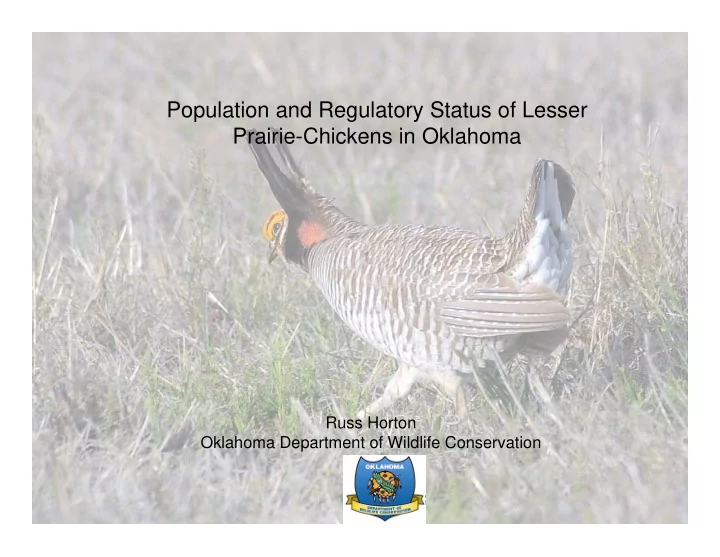

Population and Regulatory Status of Lesser P l ti d R l t St t f L Prairie-Chickens in Oklahoma Russ Horton Oklahoma Department of Wildlife Conservation
LPCH Status in Oklahoma LPCH Status in Oklahoma • Gamebird • Closed Season (since 1997) Closed Season (since 1997) • Stable Population – Low densities L d iti – Restricted Range
LPCH M LPCH Monitoring in Oklahoma it i i Okl h •Lek Detection Routes • 10 Mile Stop ‐ and ‐ Listen Routes 10 Mil S d Li R • 3 minute listening period • Late March • Late March – Early May Early May • Assume survey area of 20 mi 2 • 6 counties in NW Oklahoma 6 co nties in NW Oklahoma • Determine Lek Density
Number of active Leks 18 16 ks 14 14 er of Lek 12 10 8 Num b 6 4 2 0 0 2 3 4 5 6 7 8 9 0 1 2 3 4 5 6 7 8 9 9 9 9 9 9 9 9 0 0 0 0 0 0 0 0 0 9 9 9 9 9 9 9 9 0 0 0 0 0 0 0 0 0 1 1 1 1 1 1 1 1 2 2 2 2 2 2 2 2 2 Year
LPCH M LPCH Monitoring in Oklahoma it i i Okl h •Lek Flush Counts • 1 ‐ time flush count of all known leks 1 i fl h f ll k l k • Count all LPCH flushed • No Gender Differentation • No Gender Differentation • Late March – Early May • Determine Lek Attendance • Determine Lek Attendance
Average Number of Lesser Prairie Chickens per Lek 12 c k e n s 10 r o f C h ic 8 6 4 N u m b e r 2 0 2 2 3 3 4 4 5 5 6 6 7 7 8 8 9 9 0 0 1 1 2 2 3 3 4 4 5 5 6 6 7 7 8 8 9 9 9 9 9 9 9 9 0 0 0 0 0 0 0 0 0 9 9 9 9 9 9 9 9 0 0 0 0 0 0 0 0 0 1 1 1 1 1 1 1 1 2 2 2 2 2 2 2 2 2 Year
Chronology Petition to list received by USFWS Petition to list received by USFWS – October 5, 1995 October 5 1995 Candidate status conferred – June 9, 1998 – warranted for listing as threatened, but precluded by higher i i i priority listing actions (LPN = 8) Annual assessments Current candidate assessment Current candidate assessment Future ?
THREATS (Range-wide) The present or threatened destruction, modification or curtailment of its habitat or range. Conversion of Prairie and Native CRP to Cropland Grazing Management Habitat Fragmentation i i Wind Energy Development Oil and Gas Development p Fire Suppression and Tree/Shrub Encroachment
THREATS THREATS Over-utilization for commercial, recreational, scientific, or educational purposes. d ti l Disease or predation. The inadequacy of existing regulatory mechanisms.
THREATS Other natural or manmade factors affecting its continued existence. Nest Parasitism and Competition by Exotic Species Insecticides Herbicides Herbicides Hybridization Collision Mortality Drought
Pre-CRP Post-CRP
Kansas Survey Data – LPC/Square Mile (6 County Mean) 10.0 9.0 8.0 7 0 7.0 6.0 5.0 4.0 3.0 2 0 2.0 1.0 0.0 1984 1985 1986 1987 1988 1989 1990 1991 1992 1993 1994 1995 1996 1997 1998 1999 2000 2001 2002 2003 2004 2005 2006 2007 2008
Listing Priority THREATS THREATS TAXONOMY TAXONOMY PRIORITY PRIORITY Magnitude Immediacy High Imminent Monotypic species 1 Species Species 2 2 Subspecies/population 3 Non-imminent Monotypic species 4 Species 5 Subspecies/population 6 Moderate Imminent Monotypic species 7 to Low Species 8 Subspecies/population S b i / l i 9 9 Non-imminent Monotypic species 10 Species 11 Subspecies/population p p p 12
ESA Implications ESA Implications ESA section 9 violations of take prohibitions “…to harass, harm, pursue, hunt, shoot, wound, kill, trap, capture, or collect, or to attempt to engage in any such conduct.” ESA section 7 consultations [7(a)(2)] “Each Federal agency shall… insure that any action Each Federal agency shall… insure that any action authorized, funded, or carried out… is not likely to jeopardize the continued existence of… or result in the destruction or adverse modification of (critical) ( ) habitat….” ESA conservation and recovery tools ESA conservation and recovery tools
Threats to Lesser Prairie-chicken � Habitat fragmentation � Agricultural conversion of � Agricultural conversion of prairie/native CRP � Energy development gy p � Fire suppression � Eastern redcedar encroachment � Collision mortality � Periodic drought
FUTURE ???? FUTURE ????
Recommend
More recommend